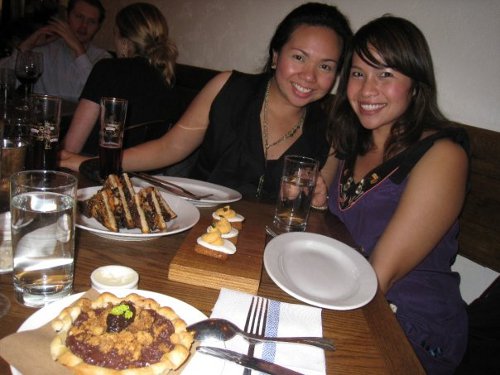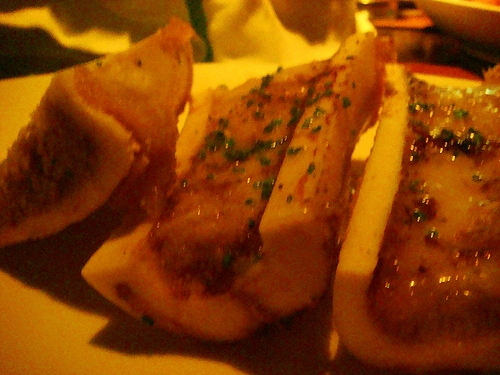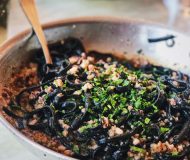In 2002, we had a feast fit for a king. It was in the Philippines, before I moved to the United States, and it was my grandfather’s birthday. We had all the usual Filipino fare, including kare-kare, a beef stew made with peanut sauce, string beans, cabbage, tender ox tail, chewy tripe and soft, jiggly, fatty intestines. We had menudo, a tomato-based pork dish made with carrots, potatoes, chickpeas, more tripe and rich, delicious liver. And we had lengua, soft braised beef tongue in a thick mushroom sauce.
But the star of the celebration that day was – nope, not my grandfather – the lechon de leche, or roast suckling pig. Lechon is a whole pig spit-roasted over red-hot coals and stuffed with fragrant tamarind leaves or lemon grass, shallots, garlic, leeks and pepper. I love it, with the golden brown skin, crispy and crackling, and the juicy meat, marbled with fat. My aunts and uncles were fighting over the various parts of the pig: its ears, its snout, its trotters, its curly crispy tail. I glanced over the birthday celebrant and I noticed that he, like me, was blissfully satisfied with heaping portions of skin and rib meat.
When I recount this story to Filipino friends, their mouths water. But when I tell it to my American friends, they’re grossed out – or at least they used to be.
The Pig Has Arrived
Fast forward to Boston, eight years later, and I see all these exotic items – the dishes of my childhood – popping up in menus of the city’s trendiest restaurants. Nose to tail eating, also called head-to-tail eating, is a burgeoning food trend in the U.S. It has been described by food bloggers as a “food fashion trend: offal, sweetbreads, pigs ears, feet and more,” and a “fine dining trend that bridges cultures, tradition and innovation” or a way to “dress up less popular cuts of meat.” Except these cuts of meat are gaining fast popularity among foodies.
One of Boston’s most well-known chefs, the dashing Ken Oringer, serves scrumptious tongue tacos at his La Verdad restaurant near Fenway Park, which is described in the menu as “benny lengua – braised tongue, salsa arbol, cilantro and onion.” That dish is so popular that on several occasions when I tried to order it, it was sold out. Another local star chef, Tony Maws, is famous for his crispy pig tails at Craigie on Main in Cambridge. SeriousEats heaps praises on the chef and the food, particularly on what was described as the most memorable dish of the night:
“Maws topped thin handkerchiefs of housemade pasta with a ragu of pork heart sausage, sea urchin, and morel mushrooms—the faint iron tang of the pork heart pairs strangely and beautifully with the funky, oceanic quality of the sea urchin, which in turn dissolves over the pasta…. This dish could convince you that Italian grandmothers had been making pork heart-sea urchin ragu for centuries.”
There’s also Julie Powell, author of Julie and Julia, the blog that turned into a book that turned into a movie, who is lyrical about beef liver in her latest memoir, Cleaving. In a recipe she calls “Valentine’s Day Liver for Two,” Powell claims that “beef liver cooked like this [pan fried in butter and oil] – I keep telling people in the face of near-universal scoffs of disbelief – is one of the most, well, passionate things you’ll ever eat… It’s as sexy as hell, but difficult too.”
Beef tongue? Pork hearts? Liver? Suddenly all these parts of the animal are considered chic, ingenuous, tasty, even sexy. But for me, these are… normal. In the Philippines where I grew up, these “exotic” items (tripe, pig’s tails, calf brains, chicken feet, blood sausage, innards, and more) were part of our daily menu.
Boston Globe restaurant critic and local food writer Devra First wrote an article called “From Snout to Tail,” featuring Jason Lord and Julie Biggs of Formaggio Kitchen, who hosted a pig butchering session in their Cambridge gourmet food shop earlier this year. “People used to use the tails and ears and all these parts because they had to; they were poor. But now chefs have reclaimed it, given it a kind of glamour,” First said. The chefs agreed, with Lord stating, “before it was a necessity, curing and storing and using every bit. Now it’s more for fun and to eat something daring.”
For fun, indeed and it looks like the rest of the country feels the same way. But while everyone is having fun, who is really paying for and benefiting from this trend?
From Nose to Tail, Charlotte to New York, Bizarre Foods to Top Chef
In an article called “The Belly of the Beast” from the Charlotte Observer, Kathleen Purvis wrote, “Pork belly, of all things, has become a food world darling.” She waxes poetic about it, starting her essay with “Meat in the middle. Soul in the edge. Pork belly inspires thoughts like that for me. Maybe it’s just the fat rushing to my brain.”
Pork belly is the baby step in nose-to-tail eating; it is essentially bacon, which almost everyone loves, but thicker, more tender, and adapts to a lot of savory flavors. While it’s true that many people are repulsed by the idea of eating squishy pork fat, there are also many who embrace it, cholesterol-ridden fat and all. In “Fat, Glorious Fat, Moves to the Center of the Table,” Frank Bruni, former food critic of the New York Times, talks about the fattiest restaurants in New York today – places serving fat unapologetically. Some of the dishes and restaurants he describes include a pork butt (which, by the way, is a term that refers to the pig’s shoulder and not its actual behind) at Momofuku, a terrine of oxtail and pig’s foot at Trestle on Tenth, and the deep fried pork jowl at Resto.

last year at Resto, we had blood sausage tart and deviled eggs served on top of those deep fried pork jowls
TV personality Chef Mario Batalli serves various organ meats and many fat incarnations at his restaurants. In his Manhattan outposts, lardo – which is a cured strip of pork fat with rosemary and other herbs – is offered on pizza at Otto and as a bruschetta at Babbo. A few years ago, he didn’t have the nerve to call lardo what it is. Instead, he invented the term “prosciutto blanco.” In an interview with Frank Bruni, Chef Batalli says, “I knew they wouldn’t eat it if I just said, ‘This is the fat of the pig melted onto toast.’” However, he notes that now, “lardo is sought after… People finally realize that fat is truly delicious, particularly pork fat.”
Nose-to-tail eating is not just about pork belly and fat, though; it is also about eating different meats from different animals. Scott Gold, who turned his blog ShamelessCarnivore into a book, writes about his experience in an Ecuadorian restaurant in Brooklyn that specializes in serving guinea pig:
Yes, guinea pig. Even more so than rabbit, the notion of eating guinea pigs elicits from most Americans a loathing and disgust they’d normally reserve for, say, devoted followers of the Church of Satan, or those perverts nabbed red-handed by Chris Hansen on Dateline’s “To Catch a Predator.” They may not say it outright (well, some do) but most people, when I tell them I’ve eaten guinea pig, are quick to see me as some kind of sick deviant.
Deviant behavior or not, the thrill of eating something that used to be a cultural taboo is the reason why nose-to-tail eating is growing fast in America. Multicultural Americans are not only going back to their roots through native dishes but are introducing other Americans to it as well. The converts then embrace it, tinker with more recipes, and come up with their own variations of these formerly non-traditional dishes. How did the chefs at chi-chi restaurants in the city suddenly come up with the idea of serving bone marrow butter with their rib eye steaks? Probably after their Mexican-American friends invited them to a home-cooked meal and introduced them to the slow-braised cuts of beef. Or maybe after their Italian nonnas prepared osso bucco for dinner and instructed them to scoop out the gelatinous filling…
It’s not just Americans with foreign lineage who are introducing nose-to-tail eating to fellow foodies; it’s also world travelers who are eager to bring back a taste of the exotic. In 2007, American journalist and food writer Calvin Trillin travelled to Singapore and became hooked on Southeast Asian cuisine. In an article for the New Yorker called “Three Chopsticks,” Trillin wrote about his Singaporean food adventures, citing local delicacies such as kueh chap, “a bowl of broth with sheets of rice-flour noodles served with pig intestines, or “spare parts.’” Now he dreams of a hawker center in New York, with stands run by vendors from various ethnicities, selling food from different parts of the world, from different parts of the animal. A famous writer who wants to set up an international food center to cater to Americans with similar cravings? Sounds like a good business plan to me.
The Travel Channel’s Bizarre Foods with Andrew Zimmern, first broadcasted in 2007, is one of its most popular shows. Yet it seems to me that the “shock factor” has decreased – mostly because regular viewers of the show, who are not squeamish to begin with, are already familiar with unique delicacies around the world; also, these “bizarre” foods can now be easily accessed through local restaurants. Another Travel Channel Show, Anthony Bourdain No Reservations, has the chef traveling all over the U.S. and the world, trying different cuisines. He often makes comparisons of the food and places with his hometown New York, and becomes a one-man PR show highlighting the varied dishes – particularly offal – that a given foreign city has to offer. And in Bravo’s Top Chef, last year’s “fan favorite” Kevin Gillespie is a self-confessed pork-lover (he even has a pig tattoo), who often made rich and decadent dishes using pork belly. He and other contestants are praised for “getting out of their comfort zone” every time they use offal as an ingredient.
It seems that while a few years ago, the novelty of using these less traditional cuts of meat got viewers watching – out of curiosity or even disgust – nowadays American viewers are more familiar with these foods and they are no longer presented as shocking. In fact, viewers are now tuning in to learn more and to salivate over the dishes themselves.
Google Trends, which tracks average website traffic based on the words used in Google searches, proves this point: up until 2006, searches and news features in the U.S. for “offal” were virtually non-existent; it slowly started ramping up in 2007, and by 2009 and 2010, the word “offal” was appearing frequently on Google News stories.
Eating Everything, Locally
Back in Boston, I attended a local fundraising event in April called Chef Louis Night. The event cost $43 per ticket, with donations going to a Haiti Relief Effort. Chef Louis started in 2004 as a local culinary underground dining scene. This evening there were oysters, cocktails, and a menu centered on a “very large pig” from Codman Community Farms in Lincoln, Massachusetts. I, like other attendees, expected unique and untraditional pork dishes. We were served a prosciutto and strawberry salad, pork sausages and shredded pork with lettuce cups, little pork-belly sandwiches, home fries or potato hash with pancetta, and boiled pork loin – all delicious but not terribly exciting.
One of my friends expressed disappointment that the chefs did not cook the pig’s head and trotters. “Instead of putting it on display,” she said, “they could’ve done something delicious with it.”
I wonder, if this event had happened ten years ago, what were the chances that charity dinner attendees would expect a pork head terrine or crispy pork skin?
Another event attendee, who has lived in Boston for ten years and likes to attend culinary events like this, also lamented the lack of “creativity” in using the pig parts. She calls herself a “native pig eater” and said “it’s a shame that the tastiest parts of the pig [the pork cheeks and hocks] were the only part of the pig that we didn’t get to sample.”
Louie DiBiccari, chef de cuisine of Sel dela Terre restaurant and founder of Chef Louie Night, is known for his menus that highlight a passion for house-made hams, sausages, pâtés, and terrines. During the event, he discussed the dishes served and peppered each explanation with tidbits on using local suppliers and vendors. He is a big proponent of locavore eating, and tries to source locally as much as he could. This evening, he emphasized politics rather than the titillating appeal of unfamiliar food.
Michael Pollan, author of books such as In Defense of Food: An Eater’s Manifesto, The Omnivore’s Dilemma, and Food Rules, is one of most famous locavores. He champions simple, sensible eating drawn from a variety of ethnic and cultural influences. For Pollan and many of his middle- to- upper-class devotees, it makes sense that if a local chef (or regular consumer with above-average food prep skills) buys a whole hog from a nearby farm, he might as well use whatever he can from the animal. It is economical, more nutritious, and better for the environment, Pollan and others argue. Given this politically-correct gloss, nose-to-tail eating is a win-win situation for everyone. But what if the eater is not an upper middle-class foodie or a denizen of Cambridge or Berkley? And who benefits most financially from promoting this style of eating?
But What If You Can’t Afford It?
In ABC’s Jamie Oliver’s Food Revolution, the chef embarks on a monumental campaign to ensure that every child, every family in America, eats “real, honest, wholesome food.” In one episode, in which he tried to make-over the lunch menu at a middle school, Oliver was preoccupied with not being able to afford fresh ingredients from local producers. Instead of getting the fresh chicken he was planning to roast, they were sent pre-cooked, heavily-breaded, preservative-filled fried chicken. Oliver then met with local bigwigs to try to raise money because now, in addition to helping people make healthier choices, he was faced with another challenge: how can you eat local when you can’t afford it? In the world of nose-to-tail eating, this might be called the poor foodie’s dilemma: How can you eat the head cheese and sweet breads when it’s so expensive?
Remember that these left-over parts of the animals used to be junk; chefs were literally throwing them away, or grinding them up for dog food. Now offal, tripe, blood sausage and the like take center stage as hip menu items. In countries like the Philippines, China, Mexico, Brazil – almost in every country across the world – these indigenous parts were cooked as “poor people’s food,” because they are so cheap and readily available. But in the U.S., they have become part of a fashionable trend that, as most restaurant trends do, caters to people with more cash to spare.
Entrepreneurial chefs are capitalizing on this food trend, essentially ripping off customers by selling cheap cuts of meat for premium prices. Celebrity chefs like Anthony Bourdain, whose net worth is rumored to be 6 million dollars, and local “rock star” chefs like Ken Oringer, who now presides over five Boston hot spots, are definitely reaping financial benefits. But who can blame them, when the adoring public is willing to fork over a lot of dollars for a few teeny tiny bites of sweetbread, a dish made with a young calf’s thymus gland and pancreas.
Adventurous Eating
I remember a particular dinner at one of my favorite restaurants: KO Prime in downtown Boston, a chic little steakhouse buzzing with young energy. Our table decided to be adventurous (and go broke) by ordering the most exotic things off the appetizer menu. We had roasted bone marrow (three giant bones served on top of a beef tongue marmalade, with crispy toast points), calves brains (served as an open faced sandwich on top of bread, with a creamy sauce — no longer on the menu), escargot, and a soft-shell crab sandwich, with the crab meant to be eaten whole.
My table companions, who were all Americans, ooohhhed and aaahhhed after tasting each dish. The calves brains were not a big hit (probably why it’s not on the menu anymore) – I ended up eating most of it – but everyone agreed that it tasted almost like scrambled eggs whites. The bone marrow and the beef tongue, however, were clear winners; we almost licked that plate clean.
“It tastes like butter,” my friend swooned, as he spread the marrow on his piece of crusty bread.
“Really fatty butter,” I corrected him, as I spooned some more of the gelatinous material from the bone. “I used to eat this all the time in the Philippines,” I bragged. “But in much bigger quantities.”
It made me think of my grandfather again. During celebrations, he loved being surrounded by food. But he uses food for other times too. I remember when I was a young child, and I had a cold and wanted to be coddled. He ordered my nanny to cook some homemade soup of calves brains, clear broth and thin vermicelli noodles. I filled up on the calves brain soup, as I filled up with his love, and felt right at home. And I didn’t have to pay a single cent for it.








 Hi! I’m Bianca Garcia. I love food, running, yoga, sangria, and my job. I'm an advertising professional, social media enthusiast, blogger, freelance writer, and obsessive list-maker. I think about dessert constantly.
Hi! I’m Bianca Garcia. I love food, running, yoga, sangria, and my job. I'm an advertising professional, social media enthusiast, blogger, freelance writer, and obsessive list-maker. I think about dessert constantly. 







